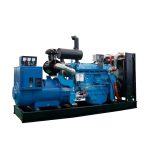Introduction
Diesel generators play a crucial role in providing reliable power supply in various applications, including remote locations, emergency backup systems, and industrial settings. However, one significant challenge faced by diesel generators is operating efficiently in low-temperature conditions. Low temperatures can impact the performance, reliability, and longevity of diesel generators if not properly addressed. In this article, we will explore the factors affecting diesel generator operation in cold environments and discuss strategies to optimize their performance for low-temperature operations.
Understanding the Impact of Low Temperatures on Diesel Generators
Diesel generators are designed to operate within a specific temperature range to ensure optimal performance. Low temperatures can have several adverse effects on diesel generators, including:
1. Cold starting issues: Diesel engines rely on compression ignition to start, and cold temperatures can make it difficult for the fuel to vaporize and ignite, leading to starting problems.
2. Lubrication challenges: Cold temperatures can cause the engine oil to thicken, reducing its flow and lubrication properties, which can increase wear and tear on engine components.
3. Battery performance: Cold temperatures can reduce the efficiency of the battery, making it harder to start the engine and maintain the electrical system.
4. Fuel issues: Diesel fuel can gel or wax in cold temperatures, clogging fuel filters and lines, and affecting the combustion process.
Optimizing Diesel Generators for Low-Temperature Operations
To overcome the challenges posed by low temperatures, it is essential to implement strategies to optimize diesel generators for cold environments. Here are some key approaches to consider:
1. Engine Block Heater: Installing an engine block heater can help preheat the engine block, improving cold starting performance by reducing the viscosity of the engine oil and aiding in fuel vaporization.
2. Coolant Heater: Using a coolant heater can warm up the engine coolant, which helps in maintaining optimal operating temperatures and ensures smooth engine operation in cold environments.
3. Battery Heating: Employing battery heaters or insulated battery blankets can prevent battery drain and maintain adequate power for engine starting in low temperatures.
4. Fuel Additives: Using winter-grade diesel fuel or adding fuel additives can prevent fuel gelling and improve fuel flow in cold conditions.
5. Diesel Generators For Sale : Manufacturers offer cold weather kits that include features such as block heaters, battery warmers, and coolant heaters specifically designed for low-temperature operations.
6. Shelter and Insulation: Providing a shelter or enclosure for the diesel generator can help protect it from extreme cold temperatures and ensure consistent performance.
7. Routine Maintenance: Regular maintenance checks, such as changing the engine oil, fuel filters, and air filters, are essential for ensuring the smooth operation of diesel generators in cold environments.
Case Study: Optimizing Diesel Generators for Arctic Operations
In Arctic regions, extreme cold temperatures present a unique set of challenges for diesel generators. Companies operating in these environments must implement specialized strategies to ensure reliable power supply. A case study of a company operating in the Arctic provides insights into the optimization of diesel generators for low-temperature operations.

Company XYZ operates a remote mining site in the Arctic, where temperatures can drop below -30°C. To address the challenges of operating diesel generators in such harsh conditions, Company XYZ implemented the following strategies:
1. Cold Weather Kits: Company XYZ installed cold weather kits on all diesel generators, which included engine block heaters, battery warmers, and coolant heaters to ensure reliable cold starting and operation.
2. Insulation and Shelter: The company constructed insulated enclosures for the diesel generators to protect them from extreme cold temperatures and harsh weather conditions.
3. Fuel Management: Company XYZ used winter-grade diesel fuel and added anti-gelling additives to prevent fuel issues in cold temperatures.
4. Routine Maintenance: The company implemented a strict maintenance schedule for the diesel generators, including regular checks on engine oil, filters, and batteries to ensure optimal performance.
By implementing these strategies, Company XYZ was able to ensure uninterrupted power supply at the remote mining site, despite the extreme cold temperatures in the Arctic region.
Conclusion
Optimizing diesel generators for low-temperature operations is essential to ensure reliable power supply in cold environments. By understanding the impact of low temperatures on diesel generators and implementing strategies such as engine block heaters, coolant heaters, battery heating, and fuel additives, operators can enhance the performance and longevity of diesel generators in cold conditions. Case studies like that of Company XYZ in the Arctic demonstrate the importance of specialized approaches for optimizing diesel generators for low-temperature operations. By leveraging these strategies, companies can maintain consistent power supply and operational efficiency even in the most challenging cold environments.
